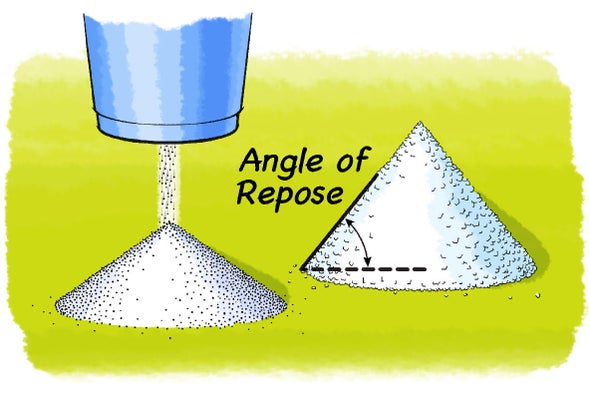Angle of Repose Experiment
The angle of repose or critical angle of repose of a granular material is the steepest angle of descent or dip relative to the horizontal plane to which a material can be piled without slumping. Abstract Snow appears as a granular material in most engineering applications.

Practical Determination Of Angle Of Repose Carre S Index Hausner Ratio Of Given Powder
When describing the angle of repose for a substance always specify the method used.

. The angle of repose Fig. Using particulate collection on small marbles the measured angles of repose compare well to experimental data and theoretical predictions. The results of both analyses are clearly correlated with systematic lower values obtained from the.
For future Mars Lander missions it is crucial to gain information about the ideal angle at which. B the mode of failure of the conical pile of. 7 is a parameter commonly used for the evaluation of interparticle force.
Two angles of repose are measured by this method. And line 1 μrpp 005 mm. The angle of repose is a measure reflecting the internal friction and cohesion properties of a granular material.
Angle of repose experiment with books it shows how friction is directly proportional to normal. The granular material will assume a certain angle as it flows within the rotating cylinder. Sliding friction governs the translational motion of particles.
More accurate simulation input parameters can improve the accuracy of simulation results 29 30. The results show that the angle of repose is dependent on the fall. Markers are simulation results.
Step 1 consists of the problem statement which is obviously related to. The morphology of the material affects the angle of repose. A funnel with a wide outlet is affixed at a distance of 10 cm above the bench where a piece of paper is placed directly beneath the funnel.
Additional information is contained in the original extended abstract. Additionally experiments were conducted with industrial mono-sized glass beads GB as a cohesionless reference. Angle of repose as a function of rolling friction coefficient between particle and wall with μspp 04 and different μrpp.
As an overall comparison of both methods we show the respective angle of repose for all experiments in a scatter plot in Figure 3. 16 The simplest method for the determination of the angle of repose is the poured angle. From the laboratory experiments the following conclusions can be made.
The role of shape was examined by investigating diverse snow types with discernable shape and spherical ice beads. UW-Madison GEOSCI 106 Fall 2019 Final ProjectRobert LegatzkeSebastian RealWill Hope. The angle of repose can range from 0 to 90.
A t-test was used for the repose angle obtained from the physical and simulation experiments to verify and determine the reliability of the simulation experiments. Solid lines are calculated results by Eq. The angle of repose of each heap was derived from the images using two independent quantities slope and area.
The rougher the base was the higher was the angle of repose. Experimental Study of the Angle of Repose of Surrogate Martian Dust Accumulation of wind-blown dust particles on solar cells and instruments will be a great challenge in the exploration of Mars significantly reducing their lifetime durability and power output. This method is recommended for obtaining the dynamic angle of repose and may vary from the static angle of repose measured by other methods.
We examined the role of grain shape and cohesion in angle of repose experiments which are a common means for the characterization of granular materials. In this paper we present an experimental setup and measurements for the angle of repose of snow for seven different snow samples over a large range of temperatures. And line 2 μrpp 01 mm.
The present work calibrates the Student Nanoexperiments for Outreach and Observational Planetary Inquiry SNOOPY Angle of Repose experiment. Angle of repose experiments In our study we focus on the influence of particle shape and cohesion on the angle of repose by comparing the angles of dif-ferent snow types at various temperatures under identical experi-mental conditions. The critical angle of repose ac is defined as the angle through which a mass of granular material can be rotated before it fails by avalanching and the angle of rest a R is defined as the inclination of the slope after avalanching has ceased.
Adapting Burdick Borror and Montgomery method the stepwise procedure for angle of repose validation must be conducted according to the Fig. Burdick Borror and Montgomery recommend that for the successful design of an experiment the decision-making process must be planned. At this angle the material on the slope face is on the verge of sliding.
A the angle of repose of the granular systems was influenced by the degree of roughness of the base on which the grains came to rest.

Slippery Slopes And The Angle Of Repose Scientific American

Practical To Determine The Angle Of Repose Of Given Sample Youtube

Sand Experiment 1 Angle Of Repose Youtube Angle Of Repose Experiments Angles

Angle Of Repose How To Perform In Laboratory Detail Calculation Importance Of Flow Property Youtube
No comments for "Angle of Repose Experiment"
Post a Comment